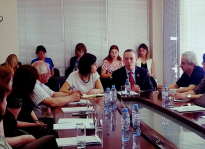
With the support of the US Embassy in Georgia, Sean Fuller, Director of NASA’s Human Space Flight Program met teachers of physics and mathematics.
The main topic of the meeting was the use of modern teaching tools to motivate students towards the technical subjects, implementation of student oriented approaches and classroom environment based on the principles of active learning.
The guest shared with the meeting participants his experience about the education and practice received at school and university level, spoke about the NASA's recent achievements and further plans to explore the space.
At the meeting, the special emphasis was made on the examples of teaching exact and natural sciences, after which students will see the connection with the natural events around them.
"After 15 years you will see that your students will be participating in development of technology. You should inspire students to put knowledge into practice. Over the last decades, engineering has made great progress and the mission of the STEM subject teachers should be to open the door of the future to new generations, "said Sean Fuller.
The teachers shared with the guest the innovative inventions that were created by Georgian students for the last period. At the meeting, Uta Kilasonia, the teacher of St Alex Shushania's school-gymnasium, talked about the impressions of his pupils who won this year's Millennium Innovation Competition and visited NASA.
"Such meetings are a stimulus for us to provoke more interest in pupils towards the technical subjects. I am looking forward to going back to school and sharing the news with my students, "said Pavle Rukhaia, the teacher of physics at Cervantes Gymnasium AIA-GESS.
The LEPL National Center for Teacher Professional Development will be implementing Millennium Challenge Account - Teachers and School Director Professional Development Project in 2016-2019. The aim of the project is to train all existing teachers of the 7th and 12th grades of public schools in the terms of student-oriented approaches and active learning strategies.
|